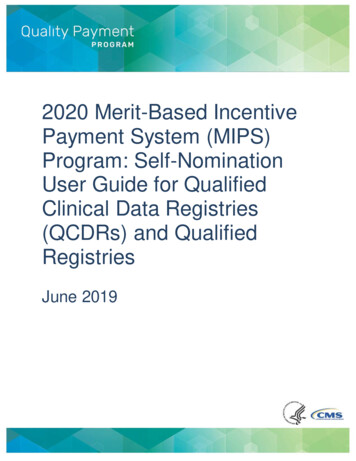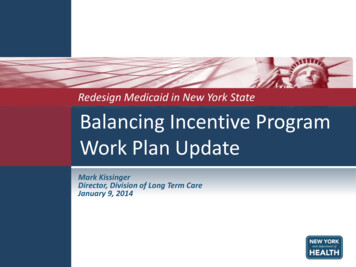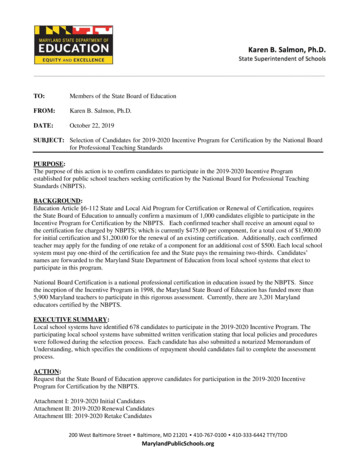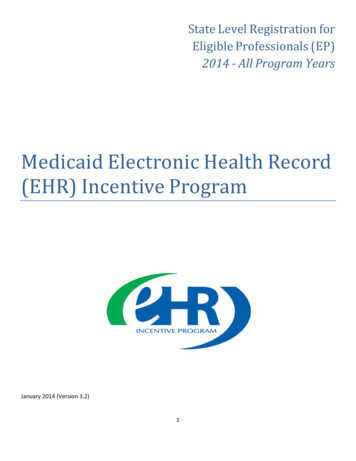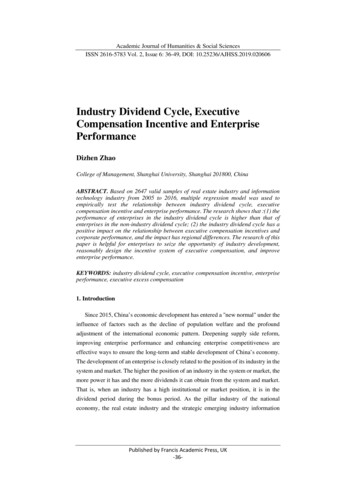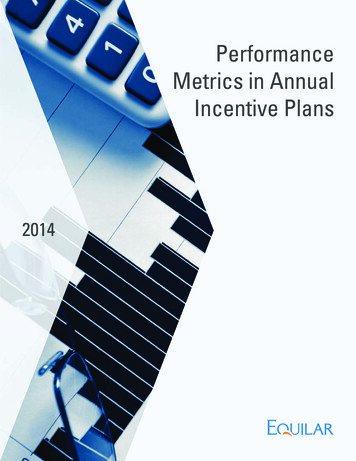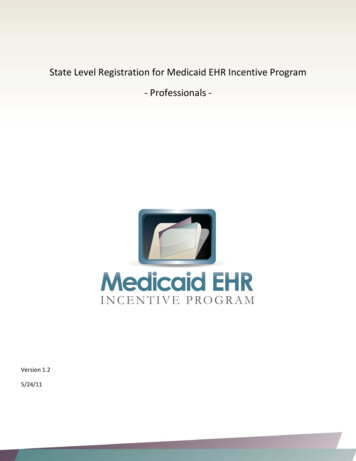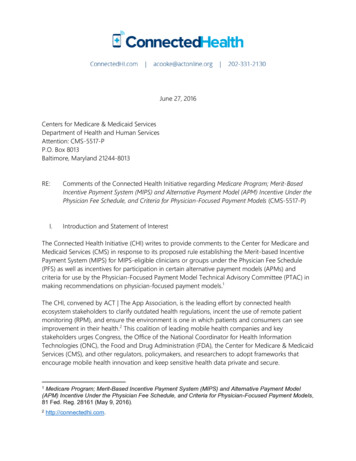
Transcription
June 27, 2016Centers for Medicare & Medicaid ServicesDepartment of Health and Human ServicesAttention: CMS-5517-PP.O. Box 8013Baltimore, Maryland 21244-8013RE:I.Comments of the Connected Health Initiative regarding Medicare Program; Merit-BasedIncentive Payment System (MIPS) and Alternative Payment Model (APM) Incentive Under thePhysician Fee Schedule, and Criteria for Physician-Focused Payment Models (CMS-5517-P)Introduction and Statement of InterestThe Connected Health Initiative (CHI) writes to provide comments to the Center for Medicare andMedicaid Services (CMS) in response to its proposed rule establishing the Merit-based IncentivePayment System (MIPS) for MIPS-eligible clinicians or groups under the Physician Fee Schedule(PFS) as well as incentives for participation in certain alternative payment models (APMs) andcriteria for use by the Physician-Focused Payment Model Technical Advisory Committee (PTAC) inmaking recommendations on physician-focused payment models.1The CHI, convened by ACT The App Association, is the leading effort by connected healthecosystem stakeholders to clarify outdated health regulations, incent the use of remote patientmonitoring (RPM), and ensure the environment is one in which patients and consumers can seeimprovement in their health.2 This coalition of leading mobile health companies and keystakeholders urges Congress, the Office of the National Coordinator for Health InformationTechnologies (ONC), the Food and Drug Administration (FDA), the Center for Medicare & MedicaidServices (CMS), and other regulators, policymakers, and researchers to adopt frameworks thatencourage mobile health innovation and keep sensitive health data private and secure.Medicare Program; Merit-Based Incentive Payment System (MIPS) and Alternative Payment Model(APM) Incentive Under the Physician Fee Schedule, and Criteria for Physician-Focused Payment Models,81 Fed. Reg. 28161 (May 9, 2016).12http://connectedhi.com.
II.Connected Health’s Integral Role in the Future of MedicareA consistently growing body of evidence demonstrates that the wide array of connected healthtechnologies available today – whether called “telehealth,” “mHealth,” “store and forward,” “remotepatient monitoring,” or other similar terms – improves patient care, reduces hospitalizations, helpsavoid complications, and improves patient engagement, particularly for the chronically ill.3 Thesetools, ranging from wireless health products, mobile medical device data systems, telehealthscreening and preventive services, converged medical devices, and cloud-based patient portals (toname a few) are revolutionizing the medical care industry by allowing the incorporation of patientgenerated health data (PGHD) into the continuum of care. To illustrate the effectiveness of thesediverse solutions, we have appended to this comment a non-exclusive list of studies we stronglyurge CMS to review.Despite the proven benefits of connected health technology to the American healthcare system,these solutions are largely ignored by the current Medicare system. For example, according to theCMS, traditional fee-for-service Medicare “telehealth” reimbursement totaled a mere 13.9 millionin calendar year 2014.4 Remote monitoring technologies, which are mostly dependent ontechnologies disallowed as telehealth services, are unreasonably restrained by CMS’ decision tobundle monitoring with other codes, resulting in a lack of reimbursement for remote monitoringsolutions.5CMS has relatively recently begun to take steps to better utilize connected health technology inseveral components of Medicare, such as for the Medicare Shared Savings Program. However, theprotracted pace at which the system is being altered to incorporate connected technologies leavesthe Medicare system and the millions of Americans it serves with outdated, inefficient, andineffective methods and treatments.With the passage of the Medicare Access and CHIP Reauthorization Act of 2015 (MACRA),Congress has very clearly directed CMS to evolve broadly the Medicare program to maximize carequality over quantity, arguably requiring the system to embrace enhancements like connectedhealth technology. Through this rulemaking, CMS has an unprecedented opportunity to improvethe American healthcare system by leveraging a wide array of connected health technologies –those available today as well as future innovations.See Hindricks, et al., The Lancet, Volume 384, Issue 9943, Pages 583 - 590, 16 August 2014doi:10.1016/S0140-6736(14)61176-4. See also U.S. Agency for Healthcare Research and Quality(AHRQ) Service Delivery Innovation Profile, Care Coordinators Remotely Monitor Chronically Ill Veteransvia Messaging Device, Leading to Lower Inpatient Utilization and Costs (last updated Feb. 6, 2013),available at http://www.innovations.ahrq.gov/content.aspx?id r example, Medicare considers CPT Code 99091 (“Physician/health care professional collection and interpretation ofphysiologic data stored/transmitted by patient/caregiver”) as “bundled” into payment for other basic services (e.g., an office visitprovided the same day or other services incident to the service provided) and therefore does not currently make separatepayment for 99091.52
We urge CMS to utilize every opportunity available to progress towards a truly connectedcontinuum of care through its implementation of MACRA. Further, CHI provides specific inputbelow on key opportunities for CMS under this rulemaking. Specifically:As a threshold issue, CMS cannot continue to rely on Medicare’s over 15-year-olddefinitional restraints on “telehealth” in 42 CFR 410.78 to serve as a definition of telehealth.To shift truly to a value-driven approach, the Medicare system must leverage the wide arrayof advanced connected health technology solutions available today, as well as futureinnovations we cannot predict. CMS should evolve its telehealth definition to one that takesa technologically-neutral approach to the use of connected health and provides theflexibility for eligible practitioners to appropriately utilize the range of these solutions,lowering costs to Medicare while vastly improving patient care. Because providers may andare encouraged to report telehealth delivered care in MIPS, it is essential that the definitionof telehealth be a technology neutral definition that may adapt with the clinical evidencebase.Congress specifically states that the Clinical Practice Improvement Activity (CPIA) “shallinclude activities such as remote monitoring or telehealth” under the Care Coordinationperformance subcategory, signaling these technologies’ importance in widely supportingproviders through the transition from volume- to value-based reimbursement. The CPIAInventory should provide a robust menu of activities that, through appropriate use ofremote monitoring or telehealth (and consumer-oriented digital and interoperableinformation technology), eligible practitioners may use for care improvement. It is crucialthat the Inventory, from which all MIPS-eligible clinicians or groups must select activities,reflects both Congressional intent and the demonstrated benefits of connectedtechnologies to the Medicare program.The Advancing Care Information (ACI) program should utilize an outcome-based approachthat incents practitioners to incorporate PGHD flexibly into their activities. Incorporatingdigital interoperable PGHD into the ACI program is consistent with the direction of HHShealth technology policy, such as the ongoing ONC effort to develop a PGHD framework.For APMs, CMS should waive the entirety of 1834(m)’s restrictions that have caused theMedicare system to utilize a backwards-looking approach to connected health technology.From the perspective of wanting to attract participants in the APM program, being able tooffer less restricted telehealth can be a reward and a competitive advantage. Further, thisapproach would allow these APMs to take the lead in demonstrating the value ofconnected health technologies in innovating care delivery and improving access andefficient delivery of care, in both rural and urban settings. APMs should also have theflexibility to provide other telehealth services, including remote monitoring for beneficiarieswith specific at-risk chronic conditions.III.CMS Should Update its Telehealth Definition of “Interactive Telecommunications Service”3
The CHI is encouraged by proposals from CMS that embrace connected health technologies. Forexample, CMS proposes to include telehealth services in the definition of patient-facingencounters.6 CMS also states that Medicare-eligible telehealth services can “substitute for an inperson encounter and meet other site requirements under the PFS as defined at 42 CFR 410.78.”7Uncertainty remains, however, about whether CMS will continue to limit unreasonably these“telehealth” services to 42 CFR 410.78’s current restraints. Specifically, because 1834(m) requiresthat telehealth utilize an “interactive telecommunications system,” we urge CMS to update properlyits now 16-year-old definition of an “interactive telecommunications system” to reflect the widerange of connected health technology available today. Furthermore, as discussed throughout thissubmission, CMS should exercise its established authority to waive arduous restrictions imposed by1834(m) on “telehealth.”The term “interactive telecommunications system” is not defined in Section 1834(m) or any otherrelevant statute text. The limited definition of this term originates in the 2001 Medicare PhysicianFee Schedule Final Rule, where CMS promulgated 42 CFR 410.78 in establishing the billing rules fortelehealth services. CMS offered the following explanation of the relevant regulatory provision inthe regulatory preamble (emphasis added):8In this final rule, we are specifying at § 410.78 that, except for the use of store and forwardtechnology in the demonstration programs conducted in Alaska or Hawaii, an interactivetelecommunications system must be used and the medical examination of the patient mustbe at the control of the physician or practitioner at the distant site. We are defininginteractive telecommunications system as multimedia communications equipment thatincludes, at a minimum, audio and video equipment permitting two-way, real-timeinteractive communication between the patient and physician or practitioner at the distantsite. We are also specifying that telephones, facsimile machines, and electronic mail systemsdo not meet the definition of an interactive telecommunications system.A patient need not be present for a Federal telemedicine demonstration programconducted in Alaska or Hawaii. We are specifying that for Federal telemedicinedemonstration programs conducted in Alaska or Hawaii, Medicare payment is permittedfor telehealth when asynchronous store and forward technologies, in single or multimediaformats, are used as a substitute for an interactive telecommunications system.Additionally, we are specifying that the physician or practitioner at the distant site must beaffiliated with the demonstration program.We are defining asynchronous store and forward technologies as the transmission of thepatient’s medical information from an originating site to the physician or practitioner at the6See 81 FR 28175.7Id.Medicare Program; Revisions to Payment Policies and Five-Year Review of and Adjustments to the Relative Value Units Underthe Physician Fee Schedule for Calendar Year 2002; Final Rule, 66 Fed. Reg. 55,281 (Nov. 1, 2001).84
distant site. The physician or practitioner at the distant site can review the medical casewithout the patient being present. An asynchronous telecommunications system in singlemedia format does not include telephone calls, images transmitted via facsimile machines,and text messages without visualization of the patient (electronic mail). Photographs mustbe specific to the patient’s medical condition and adequate for rendering or confirming adiagnosis or treatment plan.CMS’ legacy definition of the statutory term “interactive telecommunications system” to require theuse of “multimedia communications equipment that includes, at a minimum, audio and videoequipment permitting two-way, real-time interactive communication”9 is now unmistakably out-ofdate given the diverse and innovative developments in connected health technology since2001. Notably, there is no statutory restriction prohibiting CMS from replacing its outdatedreference to “audio and video equipment permitting two-way, real-time interactivecommunication” with something more modern to capture the reality of medical technologyincluding remote monitoring. This definition should be technologically-neutral and providemaximum flexibility so that eligible practitioners can appropriately utilize a range of connectedhealth solutions, lowering costs to Medicare while vastly improving patient care.10 CMS can do thisby replacing “multimedia communications equipment that includes, at a minimum, audio andvideo equipment permitting two-way, real-time interactive communication” within this definitionwith “devices and/or software permitting transmission of data.”IV.CMS Should Embrace Connected Health Technology in the MIPS Clinical PracticeImprovement Activities, Consistent with Congress’ IntentInitially, we note our support for CMS’ overall approach to the CPIA, which has taken a more goaloriented and technology-neutral approach to compliance. This shift is important because it willprovide needed flexibility to MIPS practitioners to select the most effective approaches for theirpatients. MACRA lists six CPIA subcategories that contribute to the MIPS composite score:11(1) Expanded practice access;(2) Population management;42 CFR 410.78(a)(3). We further note that Section 190 in Chapter 12 of the Medicare Claims Processing Manual notes that“[a]n interactive telecommunications system is required as a condition of payment; however, [the law] does allow the use ofasynchronous “store and forward” technology in delivering these services when the originating site is a Federal telemedicinedemonstration program in Alaska or Hawaii.”9Such an approach would be consistent with U.S. government policies supporting outcome-driven and technology-neutralapproaches in agency decisions. See, e.g., Office of Management and Budget (OMB) Circular A-4, Regulatory Analysis,available at /assets/omb/circulars/a004/a-4.pdf (“Performance standardsexpress requirements in terms of outcomes rather than specifying the means to those ends. They are generally superior toengineering or design standards because performance standards give the regulated parties the flexibility to achieve regulatoryobjectives in the most cost-effective way.”); see also OMB Memorandum on Technology Neutrality, available mb/assets/egov docs/memotociostechnologyneutrality.pdf (“.as program, IT,acquisition, and other officials work together to develop requirements and plan acquisitions, they should follow technology neutralprinciples and practices.”).1011MACRA Section 101(c)(2)(B)(iii)(II).5
(3)(4)(5)(6)Care coordination, “including use of remote monitoring or telehealth;”Beneficiary engagement;Patient safety and practice assessment; andParticipation in an APM.CMS has further proposed to add three new additional subcategories: Achieving Health Equity;Integrating Behavioral and Mental Health; and Emergency Preparedness and Response; and hassuggested comment on two further future subcategories: Promoting Health Equity and Continuity,and Social and Community Involvement.12By specifically including “shall include activities such as remote monitoring or telehealth” underthe Care Coordination performance subcategory, Congress signaled these technologies’importance in widely supporting providers through the transition from volume- to value-basedreimbursement.The CPIA Inventory should provide a robust menu of activities that, through appropriate use ofremote monitoring or telehealth (and consumer-oriented information technology), eligiblepractitioners may use for clinical care improvement. It is crucial that the CPIA Inventory, from whichall MIPS-eligible clinicians or groups must select activities, reflect both Congressional intent and thebenefits of connected technologies to the Medicare program. CMS should look for ways to provideMIPS clinicians with the flexibility in as many ways as practicable to utilize these innovations. Forexample, we believe that CMS should specify that CPIA Inventory activities may be satisfiedthrough use of any medical device that is listed (Class I), cleared (Class II), or approved (Class III) bythe FDA; or under the agency’s enforcement discretion (meaning FDA does not intend to enforcerequirements under the FD&C Act).13Further, while we appreciate CMS undertaking an environmental scan to ensure the initial CPIAInventory is inclusive of activities in line with the statutory intent,14 this evaluation must reflect thatremote monitoring or telehealth are key activities that contribute to the improvement ofbeneficiary health outcomes by reducing healthcare disparities, regardless of whether the patientresides in a rural or urban location. CMS should specify how the use of connected healthtechnologies will help eligible MIPS clinicians across each CPIA subcategory.However, as proposed, the Inventory does not reflect the unambiguous Congressional intent notedabove, nor does it adequately reflect the benefits of connected health technology to the CPIAprogram generally. For example, the Inventory contains more than 90 activities with descriptions,yet only includes two references to using remote monitoring or telehealth. Further, despite theclear language of MACRA Section 101(c)(2)(B)(iii)(II), the Inventory of activities for Care Coordination1281 FR 28212-28213.See Mobile Medical Applications, 2015 Guidance for Industry and Food and Drug Administration Staff Document, available M263366.pdf.131481 FR 28213-28214.6
contains minimal references to remote monitoring or telehealth. In addition, the CPIA Inventorycontains text that would restrict the use of such technologies to those in “rural or remote”locations, presenting the potential that onerous 1834(m) geographic restrictions might continue inthe CPIA program.We therefore request a rationale from CMS for the inadequate inclusion of remote monitoring ortelehealth in the CPIA Inventory and believe that CMS must revisit the CPIA to clearly communicateto those consulting the final rule and the Inventory the prominent role remote monitoring ortelehealth plays in satisfying subcategories across the CPIA (or, at minimum, in all CareCoordination). We believe that CMS can accomplish this in a way that preserves clinician flexibilitythrough changes to text within the “Activities” column to Table H. To assist CMS, we haveappended proposed updates to many of the Inventory’s activities with changes reviewable inredline.Further, in response to certain detailed questions and issues raised by CMS under the CPIA:In response to CMS’ request for comment on how to weigh PCMHs in the MIPS program,15we believe that PCMHs and similar Medicare demonstration models should continue toachieve the highest score for the program. In particular, CMS should factor criteria such asthe effective use of electronic tools (for example, remote physiologic monitoring, electronicdata acquisition and reminders, patient education modules, and informed decision makingtools), which should correlate with each subcategory within the CPIA Inventory.CMS requests input on the appropriate activities for non-patient-facing MIPS-eligibleclinicians or groups.16 We believe that these activities should be similar to the CMS list ofpermissible telehealth services for di
1 Medicare Program; Merit-Based Incentive Payment System (MIPS) and Alternative Payment Model (APM) Incentive Under the Physician Fee Schedule, and Criteria for Physician-F
